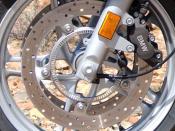Germany is a country with high standards of living, with 3 main huge car industries, and one would think that it shouldn't have many problems with road accidents. Though in 2002, .009% of the population was killed by road accidents. This may not seem much, but this equates to 7,503 lives, that's a whole lot of people dead. The primary causes for accidents are alcohol abuse and speeding. The question for us to answer is, "Is it possible that science is a contributor to these terrible statistics, or could science help to reduce the problem?" (The Road Toll Background /Task, Mr. Charters)
Science has helped us to develop new technologically advanced equipment, which will enhance driving safety. Firstly, seatbelts are a standard in cars, and have been since 1958, although it wasn't against the law not to wear them until the 1980s. It's been proven that seatbelts increase the chance of survival by 50%.
For example seatbelts save more than 17,000 lives in the USA each year. A seatbelt is a belt of material, which is attached to the upper corner of either the seat or the side of the car, and goes across your chest and lap and plug into the side of the seat. They were first created to stop the passengers from being flung forward through the windscreen when the car stops suddenly; this is the force of inertia. Inertia is the force in which an object continues to move, until it is stopped by another object. In a crash situation, if a car is going at a steady pace of 30 mph (48.3 km/h), and comes to a sudden halt, the body of the person will keep on going at 30mph, even though the car has come to a stop due to inertia. When driving in...


